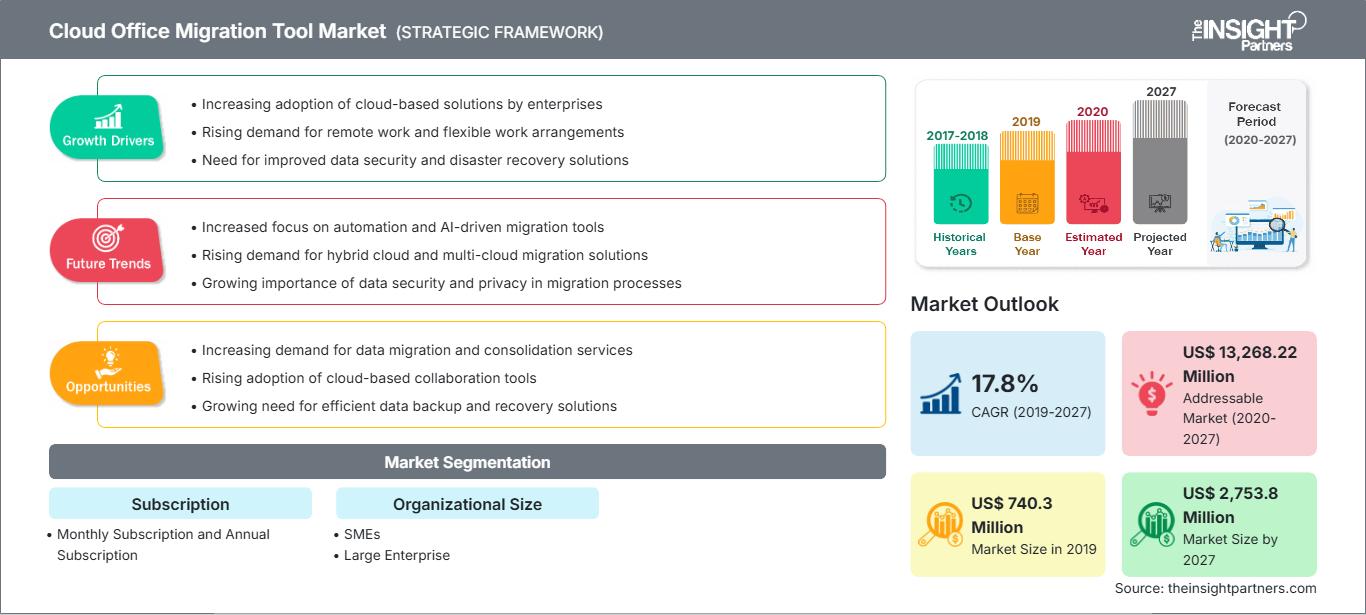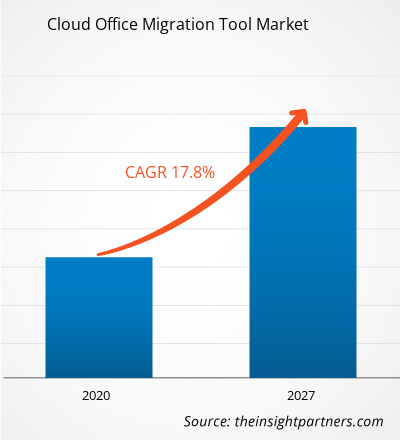Le marché des outils de migration de bureaux cloud devrait passer de 740,3 millions de dollars US en 2019 à 2 753,8 millions de dollars US d'ici 2027 ; sa croissance est estimée à un TCAC de 17,8 % entre 2019 et 2027.
Les avantages des charges de travail cloud par rapport aux solutions sur site expliquent la croissance du marché des outils de migration de bureaux cloud. Une entreprise peut avoir plusieurs objectifs pour adopter le cloud. Cela va des moteurs commerciaux, comme la transformation numérique, aux objectifs opérationnels, comme la rentabilité. Les entreprises qui gèrent leur centre de données conçoivent, dimensionnent et achètent généralement du matériel pour une application précise. Ce matériel comprend des équipements de calcul, de stockage et de réseau, entre autres équipements spécialisés. Le matériel a généralement une durée de vie de trois à cinq ans et doit être remplacé par du matériel de nouvelle génération. Les entreprises remplacent ce matériel pour améliorer leur efficacité et leurs performances. Chaque remplacement nécessite des investissements importants et des professionnels informatiques expérimentés pour gérer et maintenir le système. La charge de travail cloud est gérée et hébergée par le serveur, et son coût de mise en œuvre est inférieur à celui des solutions sur site. Les utilisateurs paient en fonction de leur utilisation du stockage cloud. Ainsi, la migration de la charge de travail peut aider les entreprises à réduire leurs dépenses d'investissement et leur permettre d'évoluer vers un modèle de dépenses d'exploitation rentable.Vous bénéficierez d’une personnalisation sur n’importe quel rapport - gratuitement - y compris des parties de ce rapport, ou une analyse au niveau du pays, un pack de données Excel, ainsi que de profiter d’offres exceptionnelles et de réductions pour les start-ups et les universités
Marché des outils de migration de bureaux dans le cloud: Perspectives stratégiques

- Obtenez les principales tendances clés du marché de ce rapport.Cet échantillon GRATUIT comprendra une analyse de données, allant des tendances du marché aux estimations et prévisions.
Analyses du marché – Marché des outils de migration vers le cloud bureautique
Croissance de l'adoption des infrastructures hybrides et multicloud
On prévoit que, dans les années à venir, diverses organisations adopteront des stratégies hybrides et multicloud, car ces systèmes sont tendance dans les secteurs concernés. Les organisations devraient opter pour ces stratégies car elles hésitent à dépendre d'un seul fournisseur de cloud. Selon IBM, 98 % des organisations prévoient d'utiliser plusieurs clouds hybrides d'ici 2021. Le cloud hybride offre les avantages des clouds publics et privés, en améliorant la flexibilité de travail entre les deux solutions cloud. De plus, il permet aux organisations de protéger leurs données confidentielles en les stockant dans le cloud privé, et d'utiliser simultanément le cloud public pour stocker les données publiques. De plus, il est également rentable et atténue le risque de perte d'activité. Les exigences des applications et des fonctions spécifiques varieront avec l'augmentation des services spécialisés. Cela encourage les responsables d'entreprise à opter pour des solutions multicloud et hybrides pour une gestion efficace et efficiente du système.
Informations sur les abonnements
Le marché des outils de migration de bureaux cloud est segmenté en abonnements mensuels et annuels. Le segment des abonnements annuels détenait la plus grande part de marché en 2018.
Marché des outils de migration Cloud Office
Les tendances et facteurs régionaux influençant le marché des outils de migration vers le cloud au cours de la période de prévision ont été analysés en détail par les analystes de The Insight Partners. Cette section aborde également les segments et la géographie du marché des outils de migration vers le cloud en Amérique du Nord, en Europe, en Asie-Pacifique, au Moyen-Orient et en Afrique, ainsi qu'en Amérique du Sud et en Amérique centrale.
Portée du rapport sur le marché des outils de migration vers le cloud| Attribut de rapport | Détails |
|---|---|
| Taille du marché en 2019 | US$ 740.3 Million |
| Taille du marché par 2027 | US$ 2,753.8 Million |
| TCAC mondial (2019 - 2027) | 17.8% |
| Données historiques | 2017-2018 |
| Période de prévision | 2020-2027 |
| Segments couverts |
By Abonnement
|
| Régions et pays couverts | Amérique du Nord
|
| Leaders du marché et profils d'entreprises clés |
|
Densité des acteurs du marché des outils de migration vers le cloud : comprendre son impact sur la dynamique des entreprises
Le marché des outils de migration vers le cloud bureautique connaît une croissance rapide, portée par une demande croissante des utilisateurs finaux, due à des facteurs tels que l'évolution des préférences des consommateurs, les avancées technologiques et une meilleure connaissance des avantages du produit. Face à cette demande croissante, les entreprises élargissent leurs offres, innovent pour répondre aux besoins des consommateurs et capitalisent sur les nouvelles tendances, ce qui alimente la croissance du marché.
- Obtenez le Marché des outils de migration de bureaux dans le cloud Aperçu des principaux acteurs clés
Les acteurs du marché des outils de migration de bureau cloud se concentrent principalement sur le développement de produits avancés et efficaces.
- En 2019, AvePoint a étendu sa portée dans les solutions de migration, de protection des données et de gouvernance pour les environnements Microsoft Office 365 et SharePoint en ajoutant des fournisseurs de services gérés (MSP) à son écosystème de partenaires.
- En 2019, BitTitan a renforcé sa relation de longue date avec Ingram Micro en lançant une offre partenaire mondiale exclusive pour accélérer l'adoption du cloud pour les clients partenaires. Cette nouvelle offre permet aux partenaires Ingram Micro qualifiés de recevoir des licences User Migration Bundle gratuites pour trois projets de migration à venir, soit un total de 50 licences MigrationWiz gratuites.
Le marché des outils de migration de bureau cloud a été segmenté comme suit : Marché des outils de migration de bureau cloud – par abonnement
- Abonnement mensuel
- Abonnement annuel
Marché des outils de migration de bureau cloud – par abonnement par taille d'organisation
- PME
- Grandes entreprises
Marché des outils de migration Cloud Office – par géographie
Amérique du Nord
- États-Unis
- Canada
- Mexique
Europe
- France
- Allemagne
- Italie
- Russie
- Royaume-Uni
- Reste de l'Europe
Asie Pacifique (APAC)
- Japon
- Chine
- Australie
- Inde
- Corée du Sud
- Reste de l'APAC
Moyen-Orient et Afrique (MEA)
- Arabie Saoudite
- ÉAU
- Afrique du Sud
- Reste du MEA
Sud Amérique (SAM)
- Brésil
- Argentine
- Reste de SAM
Marché des outils de migration Cloud Office - Profils d'entreprise
- AvePoint, Inc.
- Binarytree.com Inc.
- BitTitan, Inc.
- CodeTwo sp. z oo sp. k.
- Proventeq Limited
- Quadrotech Solutions AG
- Quest Software Inc.
- Sharegate Group Inc.
- Simflofy
- SkyKick Inc
- Analyse historique (2 ans), année de base, prévision (7 ans) avec TCAC
- Analyse PEST et SWOT
- Taille du marché Valeur / Volume - Mondial, Régional, Pays
- Industrie et paysage concurrentiel
- Ensemble de données Excel
Rapports récents
Témoignages
Raison d'acheter
- Prise de décision éclairée
- Compréhension de la dynamique du marché
- Analyse concurrentielle
- Connaissances clients
- Prévisions de marché
- Atténuation des risques
- Planification stratégique
- Justification des investissements
- Identification des marchés émergents
- Amélioration des stratégies marketing
- Amélioration de l'efficacité opérationnelle
- Alignement sur les tendances réglementaires




















 Obtenez un échantillon gratuit pour - Marché des outils de migration de bureaux dans le cloud
Obtenez un échantillon gratuit pour - Marché des outils de migration de bureaux dans le cloud